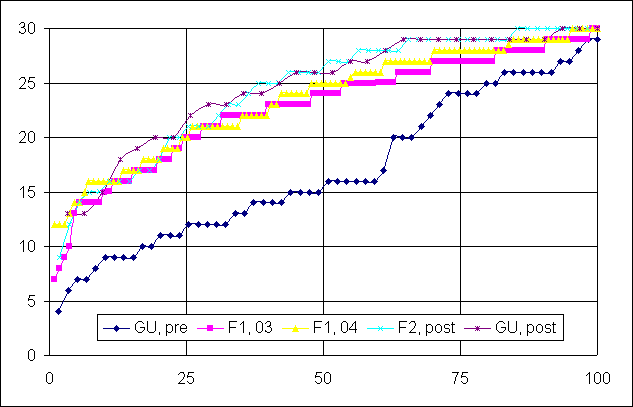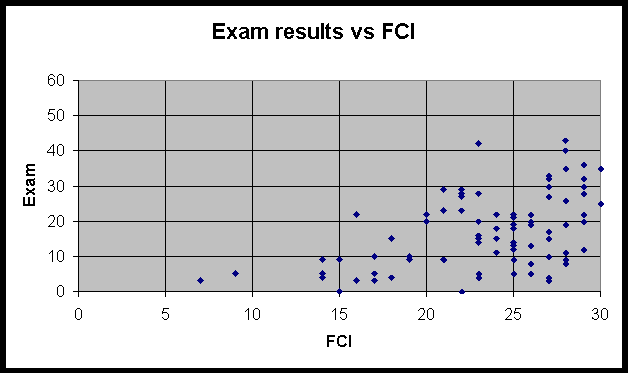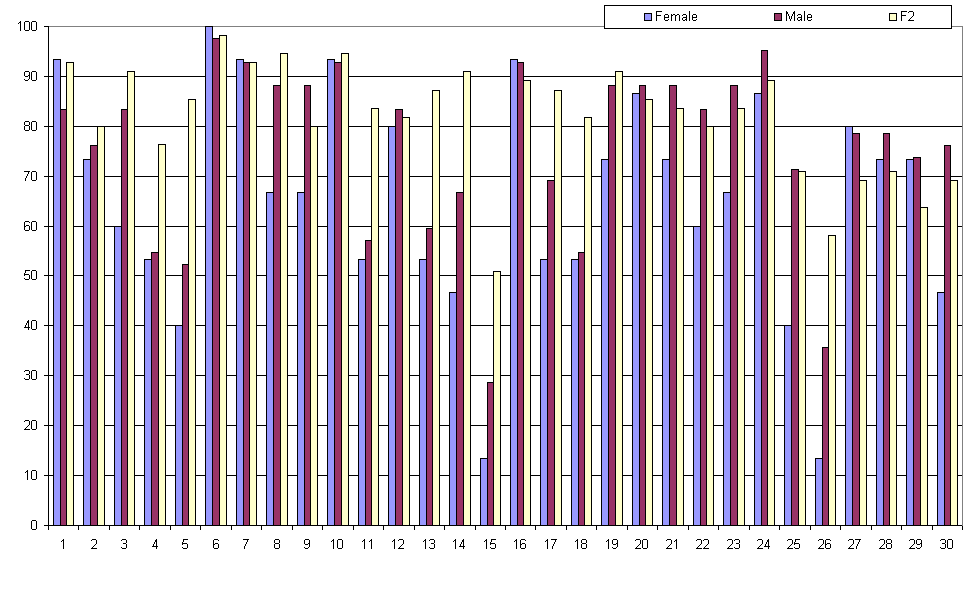Contribution to 8 Nordic Conference on Science
Education, Aalborg, 2005
University and Engineering Physics Students' Understanding of Force and Acceleration
Ann-Marie Pendrill,
Institute of Physics, Göteborg University, SE-412 96 Göteborg, Sweden
Ann-Marie.Pendrill@fy.chalmers.se
Force and acceleration are fundamental physics concepts, known to be
problematic to many students. In this work first-year physics students'
understanding of mechanics has been probed in many different ways. The
Force Concept Inventory has been for initial diagnosis, and in some
cases also for post-testing. As part of the course, the students were
assigned tasks relating the mathematical description of the motion in
amusement park rides to the experience of the body.
The results, as well as the gains exhibit considerable gender differences.
1. Introduction
Classical mechanics is a well studied area, both in physics and in
physics education and is known to cause problems for many students. In
this study, first-year physics students' understanding of mechanics has
been probed in different ways. The Force Concept Inventory has been
used for initial diagnosis of the students in the Göteborg university
physics programme, as well for engineering physics
students at Chalmers.
An amusement park visit was one of the activities included in the course
to help student develop their understanding of force and acceleration.
The
presentations of their investigations often lead to challenging physics
discussions.
2 The force concept inventory
The Force Concept Inventory (FCI) is multiple-choice test designed to
monitor students' conceptual understanding of force and related
kinematics (Hestenes et al. 1992, Halloun et al
1995). Hestenes and collaborators conclude that an FCI score of 60% can
be regarded as the 'entry threshold' to Newtonian physics and score of
85% as being Newtonian 'mastery threshold'. Hake (1998) performed
a large survey study, including data
from 62 high-school, college and entering university groups. He
introduced a normalized gain defined as
(class post-test average - class pre-test average)/
(100% - class pre-test average).
and found that "conventional instruction" tends to give normalized
gains around "1/4 of the possble gain, whereas the more interactive
physics-education-research-based classes ... typically
achieve twice as large fraction of the possible gain". The highest
normalized gain in the survey was 0.69.
In the present study, the FCI was given to entering students in the
engineering physics programme at Chalmers and in the Göteborg university
physics program.
The cumulative graphs in Figure 1 shows the distribution of individual
pre-test scores and give a visual characterization of the groups.
The
engineering physics programme (F) is highly competitive and attracts
students with a general strong interest in physics and mathematics.
The engineering physics students group has a very high average FCI score, 77% and 79%, respectively for the students entering 2003, and 2004.
Figure 1 includes also results of a post-test performed some time after the
second mechanics courses for students entering 2002, with a marginally
higher average score, 82%.
The physics programme at Göteborg university (GU) accepts a smaller number of students, but in practice all applicants who are formally qualified are enrolled, leading to a much wider distribution of scores and a lower
average, 56%. A post-test, was given, unannounced, during class the week before the exam. The 31 students who participated
achieved an average of 83%. The normalized gain for this group of students was 0.57, with large differences between male and female students as discussed below.

| Figure 1 Cumulative graph showing, on
the horizontal axis, the percentage of students having at least the FCI
score given on the vertical axis, where 30 is the maximum number of
points at the test. Each point corresponds to one individual
student.
The lower curve is the pre-test score for university physics students(GU, N=59), whereas
the upper curves refer the first year engineering physics students
starting in the years 2003 and 2004 (F1,03 and F1,04, with 110 and 111
students participating, respectively) and to post-test score for the
second-year students (F2, N=55), but also to post-test scores for the university students (N=31).
|
2.1 Test scores and exam results
The good scores of the engineering physics students were encouraging,
not least in the view of reports about declining mathematics
skills. However, the results on the mechanics exam did not meet
expectations.
Figure 2 shows the correlation between individual exam
results and initial FCI score. A first look may give the impression that
the FCI score is irrelevant for the exam result. A closer investigation of the diagram shows a remarkable lack of points in the upper left triangle. This can be taken as an indication that a good understanding of force concepts is a
necessary, but not sufficient, condition for passing the exam. During
the grading of the exam problems it was clear that lacking mathematical
skills, as well as ability to apply them in a physics context, often
raised obstacles for the students. An interview study is in progess to investigate these difficulties in more detail (Adawi et al, 2005).

| Figure 2Comparison of FCI score and exam results in the for the
engineering students entering in 2003. Each point corresponds to one individual.
The maximum number of points at the exam was 60, and the pass limit was lowered from 30 to 24.
|
|
2.2 Gender differences
For all student groups we have tested,
we have found that the subgroup of female students had lower FCI scores,
although it must also be noted that some female students were among the
top scorers in all groups.
The total pre-test score was 78% for the male engineering physics
students and 67% for the female students.
Since relatively few female
students choose engineering physics, we wanted to investigate if the
gender difference could be a possible effect of students choice of
education programme. The test was thus given also to new students in the
biotechnology program at Chalmers. This is also a highly competitive
program, but, with the emphasis on biotechnology, rather than physics,
it attracts are larger number of female students. The average pre-test
score was 54%, with the female students scoring an average 51% compared
to 60% for the male students. The post-test average was 78%,
corresponding to a normalized gain of 52%. The pre-test gender
differences were even more marked for the entering university physics
students, as discussed in more detail below.
We first look into the
response patterns the different FCI questions for engineering physics
students and, for comparison, include also the fraction of correct responses
for second-year engineering physics students.
Problem-dependent gender differences
Figure 3 shows a comparison between the fraction of correct answers for
the 2003 first-year male and female students in the engineering
programme, and also includes the results of the second-year
students. For many questions, there are insignificant differences
between the groups. For others, e.g. questions 4, 5, 13 and 18 the main
difference is between first- and second-year students, whereas for the
questions 14, 15, 17, 25, 26 and 30 a notably smaller fraction of the
female students give the correct answer.
Rennie and Parker (1998) considered the gender difference
considering the importance of real-life problems and
gender-adapted versions of the test have been designed
(e.g. McCullough and Foster, 2000).
McCullough L E and Meltzer (2001) have investigated the
gender-adapted test, and found significantly modified response patterns
for a few items. E.g.
the original FCI item 14 includes an airplane dropping a packet. When
changed to a bird dropping a fish, the fraction of correct responses
from female students in her sample changed from 22% to 55%.
Item 22 and 23 concerns a rocket, during and after using the
engines. When the rocket was replaced by a person on ice, accidentally
turning on a fire extinguisher the fraction of correct responses for
female students on question (a straight-line motion) was improved from
10% to 48%. However, McCullough and Meltzer also found a remarkable
decrease, from 47% to 18%, in fraction of correct answers for
male students for
question 22, considering the accelerated motion of the rocket/person.

|
Figure 3. Fraction of correct response for the different items in the FCI test,
for the first- and second-year engineering physics students.
For the first-year students, the results of male (N=84) and female
(N=16) students are presented separately. (The results refer to the
students starting in 2003. 16 questionnaires were handed in
anonymously).
|
Gender-dependent gain in a project-oriented course
Table I shows the pre- and post-test results for male and female
students in the University physics programme, as
well as the normalized gain. The gender
difference was very pronounced in the beginning of the course, where only
a quarter of the female students, compared to three quarters of the male
students, scored 50% or more.
The introductory mechanics course included a playground visit, student lecture demonstrations of physical phenomena and discussions about conceptual questions during lectures and problem solving classes. The students were also assigned an amusement park project.
Each group investigated one section of a roller-coaster and one other ride attraction. All groups had different tasks that involved relating the experience of the body in amusement park rides to a mathematical description of the motion, as well as to data from electronic measurements of the g-forces experienced during the ride. The tasks were relatively open-ended.
During the preparation for the visit the students had opportunities to discuss the amusement park projects with their teachers.
The results of the investigations, which were performed in groups of 6-8
students, were presented in oral and written reports. Each group was
also asked to work through the report of another group and to ask
questions after the presentation. The amusement park project was first
developed in the context of the educational programme "Problem solving
in Natural Sciences", described elsewhere in these proceedings (Hanson
and Nyman). More details about the amusement park project can be found
in previous work (Bagge and Pendrill 2002, 2004, Mårtensson-Pendrill and
Axelsson 2000, Nilsson et al 2004) and at the WWW-site, at
http://fy.chalmers.se/LISEBERG/.
The intentions behind the design of the course included student
involvement and a wide variation of taskts to accommodate different
learning styles and to help students to connect different aspects of physics
knowledge.
The results indicate that the invitations to active engagement in the course have given significant improvement on the FCI test scores.
Still, male students seem to have benefited more from the course, in terms of FCI score gain.
The large gender difference in the pre-test is thus widened for the
post-test, with the female post-test average comparable to the pretest
average for the male students.
This widening gender gap is a cause for concern and calls for closer
investigation. A possible interpretation is that the female students
took on a larger responsibility for coordinating the group work.
| Table I: Fraction correct answers in the pre and post-test FCI scores for entering university physics students. The pre-test was taken by 59 students.
The pre-test scores in parentheses correspond to 31 identifiable
students that took both the pre and post-test and are the number used
to evaluate the normalized gain.
|
| Group | Pre-test (%) | Post-test (%) | Normalized gain
|
|---|
| Male, N=35(20) | 69 (70) | 91 | 0.72
|
|---|
| Female, N=24(11) | 41 (44) | 67 | 0.41
|
|---|
| All, N=59(31) | 56 (61) | 83 | 0.57
|
|---|
3. Discussion
Although our new physics students often have a reasonably good grasp of
force concepts, and are able to work out forces in one-dimensional
situations, we have found that they often lack an appreciation of the
vector character of both force and acceleration.
Gender differences are a cause of concern.
Amusement park investigations may help develop a more complete
understanding, but the rides do not by themselves radiate knowledge.
Discussion and follow-up, including challenging students' descriptions,
are important to help students focus on
important features of force and acceleration.
The author was the examiner of the introductory physics course at Göteborg university.
I am grateful to the teachers who provided access to the other students.
Partial funding for this work was provided by CSELT - Chalmers strategic effort in learning and teaching.
Adawi T., Ingerman Å. and Pendrill, A-M. (2004), How
mathematical is conceptual understanding?,
Contribution to Physics Teaching in Engineering Education (PTEE) 2005, Brno
Bagge, S. and Pendrill, A.-M.(2002), Classical physics experiments in the amusement park, Physics Education 37, 507-511
Bagge, S (2003), Learning Physics by Experiment - An investigation of extramural learning (licentiate thesis, Göteborg University)
Bagge, S. and Pendrill, A.-M.(2004), Extramural learning at Liseberg. In E.K. Henriksen and M. Ødegaard (Ed.) Naturfagenes didaktik - en displin i forandring? - Proc. 7th nordic research symposium about science in school, Høgskolen i Agder.
Hestenes, D., Wells, M. and Swackhamer, G. (1992), "Force Concept Inventory",
Halloun I, Hake R, Mosca E and Hestenes D (1995), Force Concept Inventory, password protected at
http://modeling.la.asu.edu/modeling.html
The Physics Teacher 33,141-158
Mårtensson-Pendrill, A-M and Axelsson, M., (2000), Science at the Amusement Park, CAL-laborate Volume 5, available at
http://science.uniserve.edu.au/pubs/callab/vol5/pendrill.html
Nilsson, P., Pendrill, A-M. and Pettersson, H. (2004), Learning physics with the body, IOSTE IX.
Rennie, L. J. and Parker L H (1998) Equitable measurement of achievement in physics: high school students' responses to assessment tasks in different formats and contexts J. Women and Minorities in Sci. Eng. 4
(2-3), 113-127 (1998).
McCullough, L. E. and Foster, T.,
A Gender Context for the Force Concept Inventory, AAPT Announcer 30(4), 105 (2000) see also
McCullough L E and Meltzer, DE (2001)
Differences in male/female response patterns on alternative-format
versions of FCI items available at
href=http://piggy.rit.edu/franklin/PERC2001/McCullough.doc


